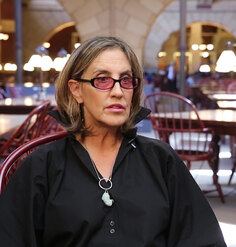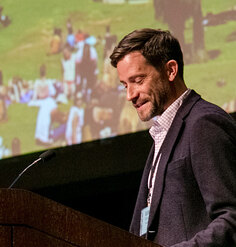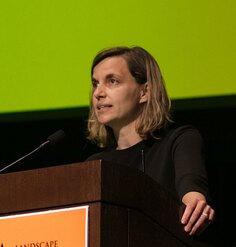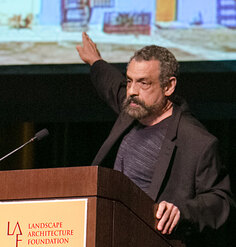Less a Declaration Than Some Thoughts
By Marc Treib
This presentation was part of the Landscape Architecture Foundation’s The New Landscape Declaration: A Summit on Landscape Architecture and the Future held in Philadelphia on June 10-11, 2016. LAF asked a diverse group of leading minds to write a “Declaration” reflecting on the last half century and offering bold ideas for how landscape architecture can make its vital contribution in response to the challenges of our time.
Marc Treib
Professor of Architecture Emeritus, University of California, Berkeley
Berkeley, California
Marc Treib is professor of architecture emeritus at the University of California, Berkeley, and a noted landscape and architectural historian and critic. He has published widely on modern and historical subjects in the United States, Japan, and Scandinavia.
*Affiliation at the time of the Summit
Less a Declaration Than Some Thoughts
By Marc Treib
While I certainly have opinions, I am not really inclined to issue declarations. Although, as colonists, we signed one rather significant statement of that sort some years ago, in the end, declarations are not very American; we leave declarations and manifestos to the Europeans. To sign a declaration suggests a concordance of thoughts and values, a rare occurrence these days, or suggests having accepted the lowest common denominator. Today, at least regarding landscape architecture, that common denominator is stewardship and sustainable practice.
It is no secret that we live in a world of divisions and polarities, a world determined, sadly, by either/ors. We are divided by red and blue states, religions and nationalities, race, warring factions, and economic classes. Unfortunately, divisions also exist between those seeking absolute bio-atmospheric sustainability and those addressing the more aesthetic aspects of landscape architecture and, if one might use that troubled word, beauty. There is no argument that a framework for sustainable existence is very much needed and a prime concern for all of us. So, if we must make any declaration in this regard, we might call it the “Declaration of Dependence”—in this case, dependence on the planet, its atmosphere, its resources, and its natural systems.
But what of the concerns that lie beyond those of basic subsistence, those addressing the quality of life, human comfort, and even individual and collective pleasure? We do not love a place because it is sustainable. We love it for its qualities beyond those of performance. If the food tastes insipid, we do not care whether it is organic or not. Without aspirations beyond achieving sustainability, the work of the landscape architect becomes only a form of environmental plumbing. We need plumbers, certainly, but we also need artists. The question, then, is what does the landscape architect contribute to the making of landscapes great and small that the biologist, hydrologist, or ethnographer does not? How does a grounding in the humanities as well as the sciences create a vision that contributes to more than mere environmental management?
An adage tells us that beauty is in the eye of the beholder. Yet, with only rare exception, cultural norms circumscribe, and therefore to some degree determine, personal aesthetic responses. Admittedly, no designer is capable of creating places perceived by everyone as beautiful or regarded as meaningful, even within the arena of a relatively small community.1 We may have some agreement on functional issues and perhaps on certain cultural values as well. But within any general consensus, considerable variations of opinion will inform the appreciation of beauty. Nevertheless, we can seek to create landscapes perceived as pleasurable and beautiful by a majority of those who visit or live in them, even if those efforts remain at the level of aspiration. Through an understanding of social mores, values, and tastes, the profession should be able to envision places exceeding in quality those already existing or those within the current memories of future occupants and users. Beauty is hardly the composition of form, space, and color alone, but more a conglomerate phenomenon that surpasses any single factor taken in isolation, just as true sustainability surpasses the checklist of factors needed to achieve LEED (Leadership in Energy and Environmental Design) certification.
Decades ago, in his own “gentle manifesto,” the architect Robert Venturi claimed his embrace of “vitality as well as validity” and “the difficult unity of inclusion rather than the easy unity of exclusion.”2 Can we not agree on an inclusive rather than an exclusive ambition for landscape architecture? Need we divide into separate camps those who stress the social, ecological, or aesthetic dimensions of landscape architecture considered only in isolation? The complexity of the commission may dictate where the stress in the design will fall; we know that time, money, and politics are often paramount in determining the design and the course of its realization. Or is that only an acceptable rationalization for dismissing concerns that also affect the lives of the individual and the community?
Sustainable is not antithetical to beautiful nor is beautiful antithetical to sustainable. Environments can, and I believe should, represent an approach of both/and rather than either/or. An exemplary landscape from the past is the Patio de los Naranjos in Seville, a setting that through almost a millennium of existence has provided a place of beauty, intelligence, and responsibility working together. Orange trees will not thrive in Seville’s climate without human support. In creating the orange grove and its courtyard—originally the forecourt to a mosque—its makers devised a system of channels by which to irrigate the trees. They did not conceive their system of irrigation without a nod to beauty, however, and sought the exquisite as well as the functional. While providing a consistent water supply tempered by controlled evaporation, the courtyard’s makers used the patterning of irrigation rills to invigorate the precisely executed ground plane of tawny brick. Standing apart from this tonal homogeneity are two overflowing fountains of marble that have shared water with the orange trees while standing as the focal points of the space.
With the Reconquest in medieval Spain, the Catholic Church superimposed a colossal cathedral upon the body of the mosque and in the process appropriated the Islamic courtyard and its orange trees. While an Islamic construction, this paradise of trees with their golden fruits possessed sufficient beauty to survive the conversion of ownership and religion. The courtyard was retained not for its harvest but for its beauty and symbolism. Beauty trumped the change of faith. While we appreciate aqueducts and expressways for their efficiency and performance, we also appreciate places primarily or solely for their beauty, with a concord somehow collectively and perhaps even mysteriously achieved. There is no reason why a landscape cannot be sustainable, ecological, resilient, robust, enfranchising—or whatever the current buzzword or interest may be—and also be beautiful.
It seems to me that the challenge to landscape architecture today is not only to achieve peace with planetary systems but also to elevate pragmatic demands to the level of poetics—in other words, treat as poetry what may first appear to be prose. In his own declaration made some 40 years ago, the sculptor Claes Oldenburg phrased it this way: “I am for an art that embroils itself with the everyday crap and still comes out on top.”3 There is a lot more crap today and more pressing issues than in the 1960s when Oldenburg made his statement, but also a lot more opportunity for pairing responsibility and beauty, not as an either/or but as a both/and.
1. For four views of this thorny subject, see Marc Treib, ed., Meaning in Landscape Architecture & Gardens (Oxon, UK: Routledge, 2009)
2. Robert Venturi, Complexity and Contradiction in Architecture (New York: Museum of Modern Art, 1966), 22–23.
3. Claes Oldenburg, “I Am For,” in Claes Oldenburg, eds. E. DeWilde and Alicia Legg (Amsterdam: Stedelijk Museum, 1970), 13.











